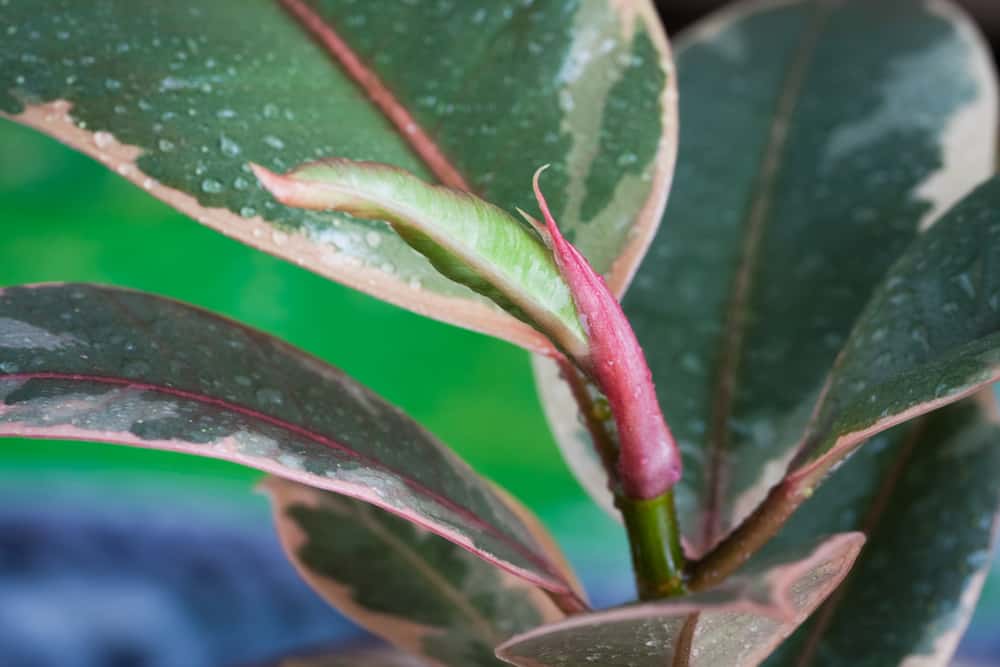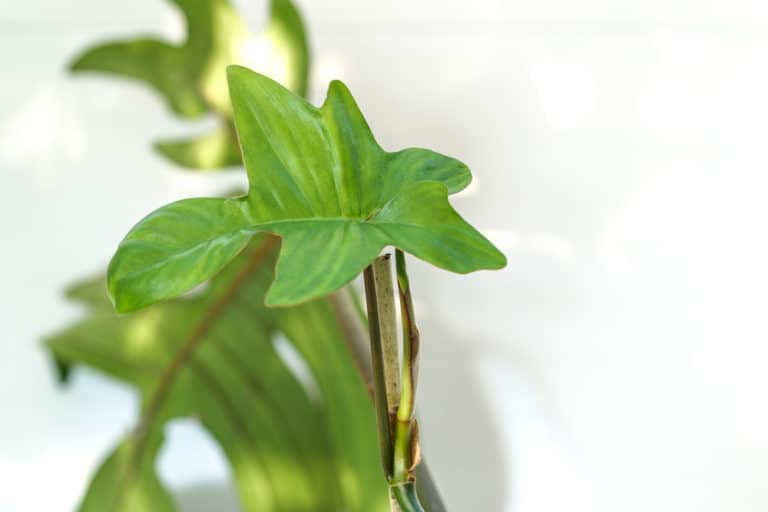Ficus Elastica ‘Ruby’ Care Guide (2024)

Big and bold, Ficus elastica Ruby is a plant that will dominate wherever it is grown.
Ficus Ruby has huge, variegated leaves and can easily reach ceiling height, making it an excellent anchor plant for an indoor tropical garden.
Even better, it’s easy to care for, even if you’re a beginner.
| Scientific Name | Ficus elastica ‘Ruby’ |
| Common Name | Ruby Rubber Tree, Rubber Fig, Indian Rubber Tree |
| Light | Bright indirect sunlight |
| Watering | Weekly, water if the top 2 inches are dry |
| Temperature | 70 to 77ºF (21 to 25 ºC) |
| Hardiness Zone | 10-12 |
| Humidity | 40-60% |
| Soil Type | Rich, quick-draining |
| Soil pH | 5 to 7 (mildly acidic to neutral) |
| Fertilizing | A balanced feed once a month in spring and summer |
| Repotting | Every 2 years |
| Pruning | In spring and summer |
| Propagation | Root cuttings in soil |
| Toxicity | Mildly toxic to most humans and pets |
| Mature Size | 8 feet as a houseplant |
| Bloom Time | Rarely flowers indoors |
What’s Unique About Ficus elastica Ruby?
Ficus elastica Ruby plants are native to the tropical zones of Malaysia and India, where rubber trees have been cultivated for rubber production.
This tropical beauty can grow to 30 feet or more when grown outside, but you can expect your potted Ficus elastica Ruby plant to top out at about ceiling height indoors.
Ficus elastica Ruby is especially popular for its attractive variegated leaves, streaked with shades of pink and red against a dark green background.
Growing Ficus elastica Ruby will also help you clean your air, as these plants can filter out mold spores and bacteria, as well as formaldehyde.
Ficus elastica Ruby Care
Ficus elastica Ruby originates in the tropical rainforests of South Asia, where it grows under the shade of the tree canopy.
The best Ficus Ruby care involves providing it with a warm, humid environment while keeping it out of the direct sun.
Ficus elastica Ruby plant care is fairly easy once you’ve met those basic requirements.
Light
In its native rainforests, Ficus elastica Ruby is used to being shielded from the hot equatorial sun by the trees that it grows under.
Ficus elastica Ruby light requirements are for bright, indirect light, or between 15,000-20,000 lux.
While they cannot tolerate full sun, they do need sufficient light to maintain the colorful variegation on their leaves which is their main appeal.
You can easily supply these Ficus Ruby light needs by placing your plant next to a north or east window, where the morning sun will not be too intense.
In south or west-facing room, however, you need to keep it away from the windows and out of the hot afternoon sun.
Watering
Ficus elastica Ruby watering should be done often enough to keep the soil uniformly moist, without it being saturated with water.
You should water Ficus Ruby when the top couple of inches of the soil have dried out, but well before the entire pot is dry.
Gently water the surface of the soil, and pour out any water that accumulates in the saucer. You cannot allow it to sit in water.
Ficus elastica Ruby’s watering needs are best met with distilled or rainwater, since the chemicals in tap water can damage the plant. If you must use tap water, let it sit overnight to allow the fluoride and chlorine to dissipate.
Temperature
In its native home near the equator, Ficus elastica Ruby is used to warm temperatures year-round.
The ideal Ficus elastica Ruby temperature range is 70 to 77ºF (21 to 25ºC). Most homes can easily supply an acceptable temperature for Ficus Ruby.
Ficus elastica Ruby has limited temperature tolerance below 60ºF (15ºC). Keep it away from drafts and air conditioning vents.
It has no frost hardiness, so if you take your Ficus elastica Ruby outside for the hot summer months, bring it in well before freezing temperatures arrive in your region. Even overnight temperatures below 60ºF (15ºC) will harm the plant.
Humidity
The tropical rainforest is a humid environment, but Ficus elastica Ruby humidity requirements are pretty easygoing.
While the ideal humidity for Ficus Ruby is between 40-60%, it will tolerate a lower humidity level.
However, if the edges of the leaves start to brown a bit, you will need to help them out.
The least expensive option is placing a pebble tray filled with water under your Ficus elastica Ruby’s pot. Evaporation will moisten the air directly around the leaves.
You can also invest in a small humidifier to keep your tropical plants happy.
Misting Ficus elastica Ruby’s leaves is not recommended.
Soil
Ficus elastica Ruby soil should be rich, and able to retain moisture, while at the same time being porous and well-draining.
The best pH level for Ficus Ruby is between 5-7, or mildly acidic to neutral.
You can use commercial cactus soil for Ficus Ruby if you can easily find it. Add some compost to boost the nutrient level of the soil mix.
You can also amend a standard potting soil to make the perfect Ficus elastica Ruby soil mix.
Use one part perlite, one part potting soil, with a good scoop of compost for nutrient-rich, well-draining soil that will stay evenly moist.
Fertilizer
You will need to use fertilizer for Ficus Ruby to ensure strong, healthy growth.
A good fertilizer ratio for Ficus elastica Ruby is a balanced 10-10-10.
Probably the best Ficus elastica Ruby fertilizer is a standard house plant liquid fertilizer, but dilute it to half the recommended strength to avoid burning its roots.
Water your Ficus elastica Ruby once a month in spring and summer, and not at all in the fall and winter when the plant is not actively growing.
Apply the liquid fertilizer directly to the soil surface shortly after watering for maximum absorption. Do not get it on the leaves.
Potting & Repotting
Ficus elastica Ruby repotting should be done every 2 or 3 years.
Ficus elastica Ruby does not grow well when it becomes excessively rootbound, so watch for roots growing out of the drainage holes.
When repotting Ficus Ruby, select a pot with good drainage. You can use a glazed or unglazed clay pot, or even a plastic one, as long as it will drain excess water.
Only move up one pot size, or at most a couple of inches in diameter. Too much room can actually set back your Ficus elastica Ruby’s growth.
Use fresh potting mix, and hold off on watering for a few days after transplanting into its new pot.
Pruning
As a general rule, you will not have to do much Ficus elastica Ruby pruning. You will, of course, need to trim off any dead or damaged leaves as they occur.
This will keep your Ficus elastica Ruby looking its best, and discourage the development of disease.
However, if you need to shape your Ficus elastica Ruby to fit into your space, you should do this in spring and summer.
If it’s reached ceiling height, simply cut the top of the main stem to halt upward growth. You can also cut out side stems just above a node.
When cutting Ficus Ruby, use sharp sterilized scissors or knives.
Propagation
Ficus elastica Ruby propagation is usually done by stem cuttings.
To propagate Ficus Ruby with cuttings, select healthy stems at least 6 inches long with 4 leaf nodes. Cut them with sharp, sterilized scissors right below a node. If you wish, you can dip the cut ends in hormone powder.
Leave the leaf at the tip of the stem, and put them in a moistened mix of peat moss and perlite. Make sure all the nodes are under the surface.
Covering the tray or pot with a plastic bag or dome will help hold in the humidity.
Set it in a warm spot out of the direct sun, and within a month or so you should have rooted cuttings ready to pot up.
Also, make sure to check out our in-depth Ficus tineke plant care guide.
Common Problems of Ficus elastica Ruby
Most Ficus elastica Ruby problems are easily prevented by providing it with the growing conditions that it needs to thrive.
However, some problems with Ficus Ruby are caused by pests or diseases that need to be treated to maintain its good health.
Keep a close eye on its leaves to catch potential problems early.
Pests
The most likely Ficus elastica Ruby pests are mealybugs and scale. If you find these bugs on your Ficus Ruby, destroy them early to prevent serious damage, and take preventative measures in the future.
Mealybugs generally congregate on the underside of leaves, looking like patches of little cotton puffs. They’re easy to remove with a cloth dipped in rubbing alcohol, followed by spraying with insecticidal soap.
Scale insects look like little brown bumps, usually on the stems but also on the leaves. They are harder to dislodge, so the best way to deal with them is by scraping them off. Then spray the whole plant with neem oil or insecticidal soap.
Diseases
Most Ficus elastica Ruby diseases are caused by overwatering.
If your Ficus Ruby is yellowing and the stems seem mushy, you may have a case of root rot. Remove the plant from the pot, and inspect the roots.
If they are turning black, you need to cut out all affected roots, leaves, and stems, and repot in fresh soil. Cut back on watering going forward.
Algal leaf spots will show up as gray, green, or orange spots on the leaves, which turn brown as they develop. It’s caused by too much humidity around the leaves, so once you’ve cut out the affected foliage, keep them dry at all times.
Growing Problems
Other growing problems are the result of unsuitable growing conditions. To bring your sick plant back to health, give it a more conducive environment for healthy growth.
If the leaves of your Ficus elastica Ruby are reverting to plain green, it’s not getting enough sun. Move it to a brighter spot to restore its variegation.
On the other hand, if the leaves are starting to look a bit brown and crisp, they’re getting too much sun. Find a shadier spot for your Ficus elastica Ruby.
If leaves are drying up and falling off, cut back on your fertilizer frequency and strength.
Toxicity of Ficus elastica Ruby
The sap of Ficus Ruby is only mildly toxic to most humans and pets.
However, while its toxicity level is low, the latex in the sap can trigger a severe allergic reaction for some people.
Care should be taken in handling your Ficus elastica Ruby to avoid any issues that may arise from exposure.
For Humans
For most humans, the worst that will happen when exposed to Ficus elastica Ruby sap is mild skin irritation.
Children are unlikely to try more than a tiny taste of a leaf, as they taste terrible. The usual result of ingesting Ficus elastica Ruby is vomiting and diarrhea as the body works to flush out the latex. This does not usually require medical attention but can be dealt with at home.
However, a small number of people have a latex allergy. Any exposure to the sap can cause an allergic reaction ranging from asthma to anaphylactic shock. Anyone exhibiting these symptoms should be taken to the emergency room immediately.
For Pets
Pets such as cats, dogs, and rabbits will also experience vomiting and diarrhea if they eat some Ficus elastica Ruby foliage. However, it’s not likely to be life-threatening, so simply treating the symptoms should be sufficient.
Placing your Ficus elastica Ruby out of reach of curious creatures can be challenging, as it is not suited to growing out of reach of animals or children. Its height and size require it to be placed at floor level.
However, you may be able to place a decorative barrier such as a trellis around the base of the pot to prevent easy access.
Ficus elastica Ruby Appearance
The Ficus elastica Ruby appearance can be summed up as big and beautiful.
The colorful variegation on its large leaves, as well as its commanding size, will make it a focal point of your tropical garden.
While you may never see a Ficus Ruby flower, the lush leaves will make up for that.
Foliage
The foliage of Ficus elastica Ruby is the reason people grow this popular houseplant, and with good reason.
Each large oval leaf features generous splashes of pink and red against a dark green backdrop on top. The texture is smooth and shiny. The undersides of the leaves are a solid pale pink or cream.
Leaves will grow to a mature size of a foot in length and half that wide. They are attached to the main stalk by thick stems. Each stem has one leaf growing from its tip.
Maintain the glossy appearance of the leaves by wiping them down once a month with a damp cloth.
Flowering
Ficus elastica Ruby flowering occurs rarely on plants grown indoors in pots. In rare instances, you will see it blooming, but the flowers are small and insignificant.
When you see a tall, narrow sheath emerging from the end of the stalk, you may think that you are about to get a Ficus elastica Ruby flower. However, this bright red sheath is in fact a new leaf getting ready to unfurl itself.
Because of the unspectacular nature of the rare flowers, it’s not worth trying to coax your Ficus elastica Ruby to produce them. Instead, focus on the gloriously variegated leaves.
Size and Growth
When grown outdoors in a tropical region, the full size of Ficus elastica Ruby can be a spectacular 100 feet or more.
However, when grown as a potted plant, it will usually finish up at about 8 feet tall, spreading out about 3 feet.
If you have a cathedral ceiling and want to aim for 12 feet or so, you may be able to achieve that in time and with ideal conditions.
Ficus elastica Ruby has a slow growth rate and may take up to 10 years or so to reach its full height indoors.
The main stem will grow into a thick trunk as it grows in height.
Ficus elastica Ruby Fragrance
There is no discernable Ficus elastica Ruby fragrance. This may be a positive for you if you are sensitive to strong scents.
However, even though it has no scent, it has other benefits for your indoor air.
Ficus elastica Ruby filters bacteria and mold spores from the air, clearing up to 60% of these harmful pathogens.
Rubber plants also filter out formaldehyde and produce more oxygen than any other plant, making them not just beautiful but useful.
Ficus elastica Ruby is an ideal plant to use in places where fragrant plants aren’t permitted, such as nursing homes, and air filtration is a positive bonus in any setting.
Suggested Uses for Ficus elastica Ruby
While you won’t want to use this big plant in a small space like a studio apartment, a Ficus elastica Ruby can make a strong statement where there’s room for it indoors.
In a public atrium with a soaring ceiling, one or more Ficus elastica Ruby plants in large planters will provide an excellent low-maintenance backdrop. One plant in a large living room or conservatory can serve as the centerpiece of an assortment of tropical plants.
You can move your Ficus elastica Ruby outside for the summer season, where it will immediately establish a tropical vibe on a shady patio.
FAQ
What is Ficus elastica Ruby?
Ficus elastica Ruby is a tropical plant native to rainforests in India and Malaysia. It is a rainforest plant often grown as an indoor potted plant.
How to identify Ficus elastica Ruby?
Ficus elastica Ruby has large, oval leaves with red, pink, and green variegation, growing at the end of thick stems. It has a thick center stalk and an upright habit.
How to care for Ficus elastica Ruby?
Ficus elastica Ruby should be grown in well-draining, rich soil and kept in bright but indirect light. Keep the soil moist but not sopping, and fertilize regularly.
How to grow Ficus elastica Ruby indoors?
Ficus elastica Ruby should be kept in a warm, moderately humid environment out of the direct sun. Water to keep the soil consistently moist but well-drained.
How to grow Ficus elastica Ruby outdoors?
Ficus elastica Ruby can be grown outdoors year-round in a tropical region. Plant it in dappled shade and do not let the soil dry out.
How fast does Ficus elastica Ruby grow?
Ficus elastica Ruby has a slow growth rate, taking 10 to 15 years to reach its full size when grown indoors as a potted plant.
How tall does Ficus elastica Ruby grow?
When grown indoors, Ficus elastica Ruby can reach a height of 8 feet or so. A Ficus elastica Ruby grown outdoors in a tropical region can reach more than 100 feet.
How to make Ficus elastica Ruby grow faster?
Ficus elastica Ruby will grow its fastest when given ideal conditions of bright, indirect light, warm temperatures, moderately high humidity, moist soil, and regular light fertilizing.
How to stake Ficus elastica Ruby?
Ficus elastica Ruby naturally grows upright with a strong central trunk, so it does not need any staking. Rotate the pot a quarter turn a week to keep it growing evenly.
How to pot Ficus elastica Ruby?
Ficus elastica Ruby should be potted in a container with good drainage holes, in rich but well-draining soil which will stay evenly moist without being saturated.
How to revive Ficus elastica Ruby?
If your Ficus elastica Ruby’s soil has completely dried out, plunge the pot into the water until it has fully absorbed the water. Let the excess water drain out completely.
Why is my Ficus elastica Ruby dying?
Your Ficus elastica Ruby may have an insect infestation or fungal disease. Use insecticidal sprays for bugs and remove diseased leaves, stems, and roots if necessary.
Why is my Ficus elastica Ruby drooping?
Your Ficus elastica Ruby may be drooping because it has been overwatered. If the soil is waterlogged, remove it from the pot and replace it with fresh, porous soil.
How cold can Ficus elastica Ruby tolerate?
Ficus elastica Ruby cannot tolerate temperatures much below 60ºF (15ºC), and freezing temperatures will kill it. Keep it at 70 to 77ºF (21 to 25 ºC).
How to get rid of pests on Ficus elastica Ruby?
Get rid of insect pests such as mealybugs and scale on your Ficus elastica Ruby by using sprays such as insecticidal soap and neem oil.
Is Ficus elastica Ruby toxic to cats?
Ficus elastica Ruby is mildly toxic to cats. If your cat eats some foliage, it will experience vomiting and diarrhea until the latex in the sap is expelled from its body.
Is Ficus elastica Ruby toxic to dogs?
Ficus elastica Ruby is mildly toxic to dogs. While ingesting it will not be fatal, your dog will be sick with vomiting and diarrhea until the latex toxins are cleared.
Is Ficus elastica Ruby toxic to children?
Ficus elastica Ruby is mildly toxic to most children, resulting in vomiting and diarrhea when ingested. A latex allergy will result in an anaphylactic reaction requiring medical attention.
Is Ficus elastica Ruby toxic to humans?
Most humans have a mild reaction to the latex in Ficus elastica Ruby sap, usually just skin irritation. People with a latex allergy should seek emergency care when exposed.
Does Ficus elastica Ruby have a scent?
The foliage of Ficus elastica Ruby has no scent, and the plants rarely if ever produce flowers when grown as a houseplant. It is considered fragrance-free.






